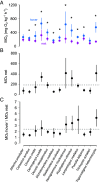Inherent instability leads to high costs of hovering in near-neutrally buoyant fishes
- PMID: 40623189
- PMCID: PMC12280926
- DOI: 10.1073/pnas.2420015122
Inherent instability leads to high costs of hovering in near-neutrally buoyant fishes
Abstract
Hovering, the ability to maintain a stationary position in fluid, is essential for many fish species during prey capture, habitat exploration, and mating. While traditionally assumed to be energetically inexpensive for fishes with a swim bladder, the metabolic costs and morphological factors influencing postural stability during hovering remain poorly understood. Hovering requires fishes to counteract small instabilities in position and orientation, often through continuous adjustments using their fins and body. To examine the energetic consequences of this active stabilization, we measured body posture, fin kinematics, and metabolic rates in 13 near-neutrally buoyant fish species during both hovering and resting. Our results show that hovering nearly doubles metabolic rates compared to resting, and species with greater separation between the center of mass and center of buoyancy and increased caudal fin activity exhibit higher energetic costs. In contrast, species with more posteriorly positioned pectoral fins and lower length-to-depth ratios show reduced hovering costs. Our findings demonstrate that, despite morphological traits that promote instability, fishes maintain posture and position through fine-scale fin control-at a significant energetic expense. This study suggests that hovering is a costly behavior that likely plays a key role in shaping the evolution of fish morphology and locomotor strategies.
Keywords: dynamic stability; fish locomotion; hovering; inherent instability.
Conflict of interest statement
Competing interests statement:The authors declare no competing interest.
Figures





References
-
- Ruiz-Torres R., Curet O. M., Lauder G. V., MacIver M. A., Kinematics of the ribbon fin in hovering and swimming of the electric ghost knifefish. J. Exp. Biol. 216, 823–834 (2013). - PubMed
-
- Vejdani H. R., Boerma D. B., Swartz S. M., Breuer K. S., The dynamics of hovering flight in hummingbirds, insects and bats with implications for aerial robotics. Bioinspir. Biomim. 14, 016003 (2018). - PubMed
-
- Warrick D. R., Tobalske B. W., Powers D. R., Aerodynamics of the hovering hummingbird. Nature 435, 1094–1097 (2005). - PubMed
-
- Weis-Fogh T., Quick estimates of flight fitness in hovering animals, including novel mechanisms for lift production. J. Exp. Biol. 59, 169–230 (1973).
-
- Webb P. W., Weihs D., Stability versus maneuvering: Challenges for stability during swimming by fishes. Integr. Comp. Biol. 55, 753–764 (2015). - PubMed
MeSH terms
Grants and funding
LinkOut - more resources
Full Text Sources

